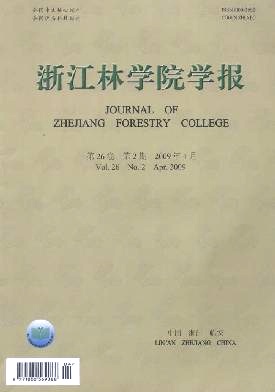| [1] |
YUAN Zixin, GUO Qiuju, AI Xunru, YAO Lan, ZHU Jiang, WANG Lei, XIANG Qin.
Comprehensive evaluation of spatial structure of four typical forest stands in Jinzishan state-owned forest farm
. Journal of Zhejiang A&F University,
2024, 41(5): 928-938.
doi: 10.11833/j.issn.2095-0756.20240162
|
| [2] |
LÜ Kangting, ZHANG Ershan, LI Siying, JIN Shanshan, ZHOU Mengli, YAN Dongfeng.
Effects of stand spatial structure on understory plant diversity in Pinus taiwanensis plantation
. Journal of Zhejiang A&F University,
2022, 39(6): 1257-1266.
doi: 10.11833/j.issn.2095-0756.20220139
|
| [3] |
WU Xiujuan, AO Xiaoping, ZHAO Yupeng, CUI Xueqing.
Spatial structure of Larix principis-rupprechtii-Picea spp. secondary forests on shady slope of Luyashan National Nature Reserve
. Journal of Zhejiang A&F University,
2021, 38(1): 58-64.
doi: 10.11833/j.issn.2095-0756.20200261
|
| [4] |
SUN Yuhan, WANG Shibo, WANG Runhan, ZHENG Xiaoyu, YAN Fei.
Spatial structure of a Pinus tabulaeformis plantation based on the Voronoi diagram
. Journal of Zhejiang A&F University,
2018, 35(5): 877-884.
doi: 10.11833/j.issn.2095-0756.2018.05.012
|
| [5] |
LIANG Senmiao, WANG Wei, QI Xingjiang, ZHANG Yu, WANG Junhong, ZHENG Xiliang, HU Guixian.
Fruit quality of'Zaojia' red bayberry fruits
. Journal of Zhejiang A&F University,
2017, 34(3): 559-564.
doi: 10.11833/j.issn.2095-0756.2017.03.023
|
| [6] |
AI Jingwen, LIU Jian, YU Kunyong, ZHANG Jinzhao, ZENG Qi, ZHENG Wenying.
Research on contribution rate of plant community characteristics and stand spatial structure to landscape aesthetics quality of forest parks and its influencing factors
. Journal of Zhejiang A&F University,
2017, 34(6): 1087-1094.
doi: 10.11833/j.issn.2095-0756.2017.06.017
|
| [7] |
FAN Peipei, WEI Xinliang, GUO Ruyi, TANG Mengping.
Forest tree spatial characteristics of a coniferous, broad-leaf mixed forest on Mount Tianmu
. Journal of Zhejiang A&F University,
2015, 32(5): 675-682.
doi: 10.11833/j.issn.2095-0756.2015.05.004
|
| [8] |
SHEN Lifen, XIANG Weibo, FAN Caiting, JIN Peng, ZHOU Mingbing, XU Chuanmei.
Biological characteristics of the Myrica rubra flower
. Journal of Zhejiang A&F University,
2015, 32(2): 278-284.
doi: 10.11833/j.issn.2095-0756.2015.02.016
|
| [9] |
DENG Hongjian, LI Weizhong, CAO Zhu, WANG Qing, WANG Guangru.
Species diversity based on sample size in a Pinus tabulaeformis mixed forest
. Journal of Zhejiang A&F University,
2015, 32(1): 67-75.
doi: 10.11833/j.issn.2095-0756.2015.01.010
|
| [10] |
ZHANG Jiecun, XU Lihua, ZHANG Maozhen, TANG Mengping.
Spatial structure and species diversity with an improved mingling index
. Journal of Zhejiang A&F University,
2014, 31(3): 336-342.
doi: 10.11833/j.issn.2095-0756.2014.03.002
|
| [11] |
WU Aibin, YOU Xianxiang, ZHAO Yanxia, QIN Yanjie, LIU Xin.
Acquisition and analysis spatial structure of Platycladus orientalis plantations based on 3S
. Journal of Zhejiang A&F University,
2014, 31(1): 57-63.
doi: 10.11833/j.issn.2095-0756.2014.01.009
|
| [12] |
WANG Qun, ZHANG Jin-chi, TIAN Yue-liang, YE Li-xin, LIU Sheng-long.
Stand spatial structure of a natural mixed forest in the Fengyang Mountains of Zhejiang
. Journal of Zhejiang A&F University,
2012, 29(6): 875-882.
doi: 10.11833/j.issn.2095-0756.2012.06.011
|
| [13] |
DENG Ying-ying, TANG Meng-ping, XU Wen-bing, CHEN Yong-gang, LOU Ming-hua, ZHAO Ming-shui.
Spatial structure of bamboo culm of an almost natural,pure Phyllostachys pubescens forest in Mount Tianmu
. Journal of Zhejiang A&F University,
2011, 28(2): 173-179.
doi: 10.11833/j.issn.2095-0756.2011.02.001
|
| [14] |
ZHANG Hui-ru, WU Ji-cheng, YANG Hong-bo, CHEN Xin-mei.
Spatial structure of mixed larch-spruce-fir stands
. Journal of Zhejiang A&F University,
2009, 26(3): 319-325.
|
| [15] |
MENG Ci-fu, CAO Zhi-hong, JIANG Pei-kun, XU Qiu-fang, ZHOU Guo-mo.
Foliar-applied boron (B) to prevent B-deficiency in red bayberry(Myrica rubra)
. Journal of Zhejiang A&F University,
2008, 25(5): 543-547.
|
| [16] |
FANG Guo-jing, TANG Meng-ping, ZHANG Xue-lian.
The mingling index with evergreen broadleaf forests on Mount Tianmu
. Journal of Zhejiang A&F University,
2008, 25(2): 216-220.
|
| [17] |
WANG Bai-po, CHENG Xiao-jian, FU Qing-gong, YU Wei-wu, WANG Hui.
Evaluation of pollution-free Myrica rubra production in Zhejiang Province
. Journal of Zhejiang A&F University,
2007, 24(5): 550-554.
|
| [18] |
MENG Ci-fu, JIANG Pei-kun, CAO Zhi-hong, XU Qiu-fang, ZHOU Guo-mo.
Boron nutrition and application to Myrica rubra
. Journal of Zhejiang A&F University,
2006, 23(6): 684-688.
|
| [19] |
LI Xiu-ting, QIU Cheng-ming, WANGBai-po, ZHANGXin-hua, SHEN Ai-qiao.
Sunlight sheds effect on earlier maturity of Myrica rubra
. Journal of Zhejiang A&F University,
2004, 21(2): 154-158.
|
| [20] |
Wang Baipo, Dai Wensheng, Cheng Xiaojian, Wang Lizhong, Yan Rongbao, Bao Lihong, Yuan Ronggen.
Performance of improved Myrica rubra varieties and cultural techniques on hillock krasnozem
. Journal of Zhejiang A&F University,
1998, 15(3): 244-249.
|









 DownLoad:
DownLoad: